University Business Plan: Solar Window Investment and Development
VerifiedAdded on 2023/01/12
|24
|4711
|24
Report
AI Summary
This report presents a detailed business plan for the implementation and investment in solar windows. It begins with a product introduction, highlighting the benefits of solar windows in generating sustainable energy and reducing carbon footprints. The report explores the investment potential, emphasizing the increasing demand for solar energy and the cost-effectiveness of solar windows compared to traditional solar panels. It includes a customer value proposition, explaining how the company aims to create an emotional connection with customers and provide a seamless user experience. A lean business model is outlined, covering problem allocation, customer segmentation, customer value, problem solutions, and revenue streams. The report also provides a financial plan, including projected cash flow, pro forma cash flow, and a break-even analysis. Furthermore, it discusses the role of the COO in the business organization and concludes with a summary of the key findings and recommendations. The report also includes important assumptions and an appendix with a projected balance sheet.
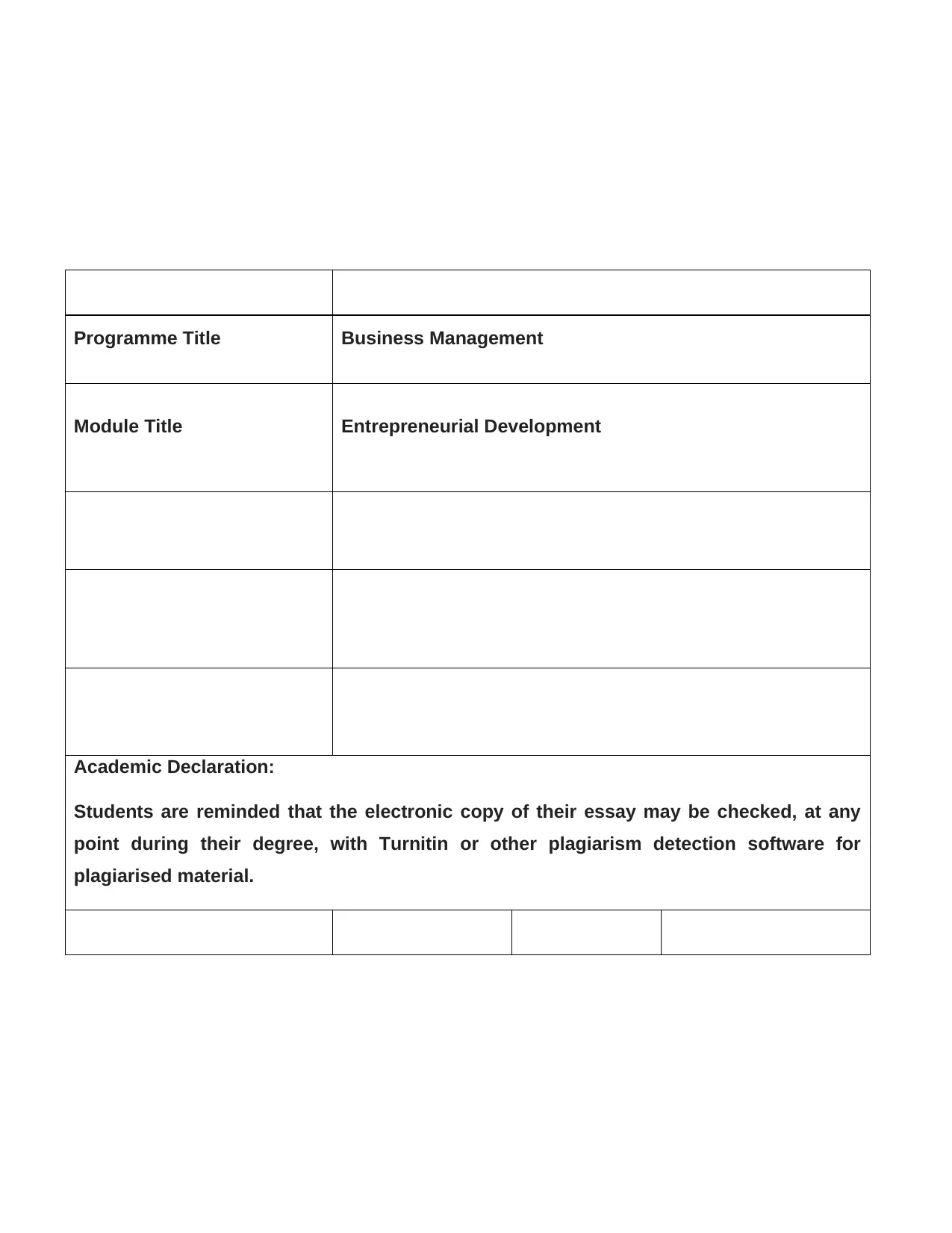
Programme Title Business Management
Module Title Entrepreneurial Development
Academic Declaration:
Students are reminded that the electronic copy of their essay may be checked, at any
point during their degree, with Turnitin or other plagiarism detection software for
plagiarised material.
Module Title Entrepreneurial Development
Academic Declaration:
Students are reminded that the electronic copy of their essay may be checked, at any
point during their degree, with Turnitin or other plagiarism detection software for
plagiarised material.
Paraphrase This Document
Need a fresh take? Get an instant paraphrase of this document with our AI Paraphraser
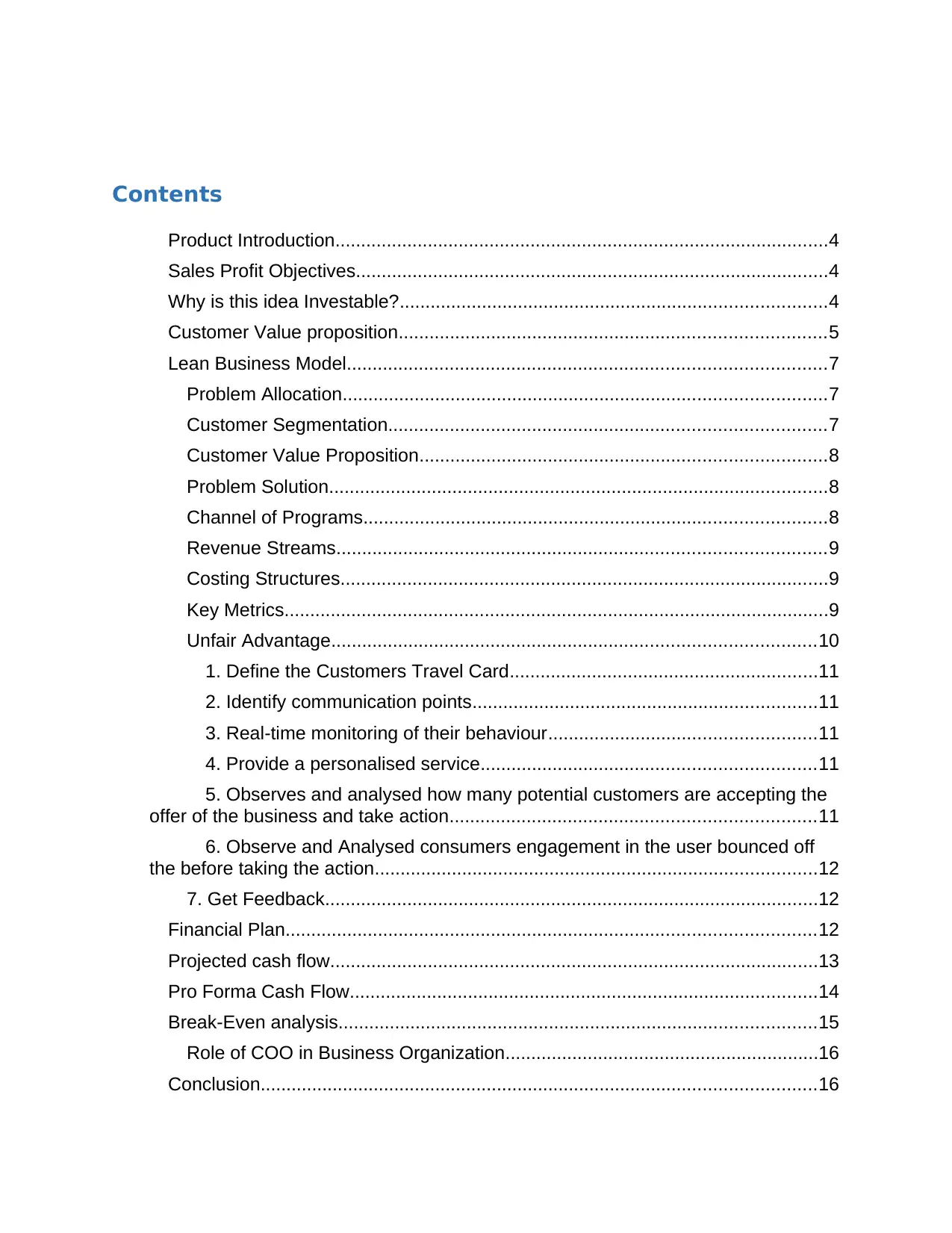
Contents
Product Introduction................................................................................................4
Sales Profit Objectives............................................................................................4
Why is this idea Investable?...................................................................................4
Customer Value proposition...................................................................................5
Lean Business Model.............................................................................................7
Problem Allocation..............................................................................................7
Customer Segmentation.....................................................................................7
Customer Value Proposition...............................................................................8
Problem Solution.................................................................................................8
Channel of Programs..........................................................................................8
Revenue Streams...............................................................................................9
Costing Structures...............................................................................................9
Key Metrics..........................................................................................................9
Unfair Advantage..............................................................................................10
1. Define the Customers Travel Card............................................................11
2. Identify communication points...................................................................11
3. Real-time monitoring of their behaviour....................................................11
4. Provide a personalised service.................................................................11
5. Observes and analysed how many potential customers are accepting the
offer of the business and take action.......................................................................11
6. Observe and Analysed consumers engagement in the user bounced off
the before taking the action......................................................................................12
7. Get Feedback................................................................................................12
Financial Plan.......................................................................................................12
Projected cash flow...............................................................................................13
Pro Forma Cash Flow...........................................................................................14
Break-Even analysis.............................................................................................15
Role of COO in Business Organization.............................................................16
Conclusion............................................................................................................16
Product Introduction................................................................................................4
Sales Profit Objectives............................................................................................4
Why is this idea Investable?...................................................................................4
Customer Value proposition...................................................................................5
Lean Business Model.............................................................................................7
Problem Allocation..............................................................................................7
Customer Segmentation.....................................................................................7
Customer Value Proposition...............................................................................8
Problem Solution.................................................................................................8
Channel of Programs..........................................................................................8
Revenue Streams...............................................................................................9
Costing Structures...............................................................................................9
Key Metrics..........................................................................................................9
Unfair Advantage..............................................................................................10
1. Define the Customers Travel Card............................................................11
2. Identify communication points...................................................................11
3. Real-time monitoring of their behaviour....................................................11
4. Provide a personalised service.................................................................11
5. Observes and analysed how many potential customers are accepting the
offer of the business and take action.......................................................................11
6. Observe and Analysed consumers engagement in the user bounced off
the before taking the action......................................................................................12
7. Get Feedback................................................................................................12
Financial Plan.......................................................................................................12
Projected cash flow...............................................................................................13
Pro Forma Cash Flow...........................................................................................14
Break-Even analysis.............................................................................................15
Role of COO in Business Organization.............................................................16
Conclusion............................................................................................................16
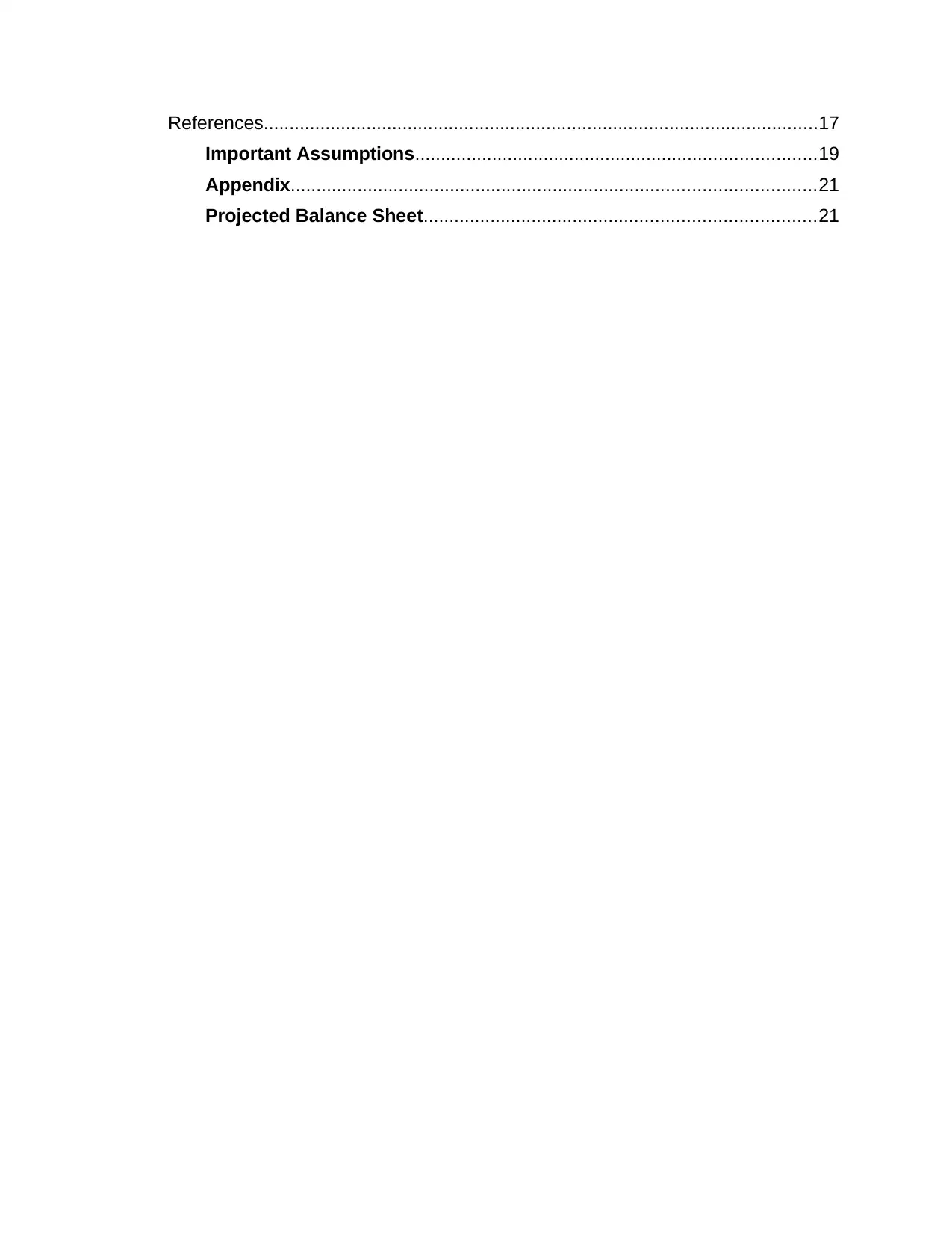
References............................................................................................................17
Important Assumptions..............................................................................19
Appendix......................................................................................................21
Projected Balance Sheet............................................................................21
Important Assumptions..............................................................................19
Appendix......................................................................................................21
Projected Balance Sheet............................................................................21
⊘ This is a preview!⊘
Do you want full access?
Subscribe today to unlock all pages.

Trusted by 1+ million students worldwide
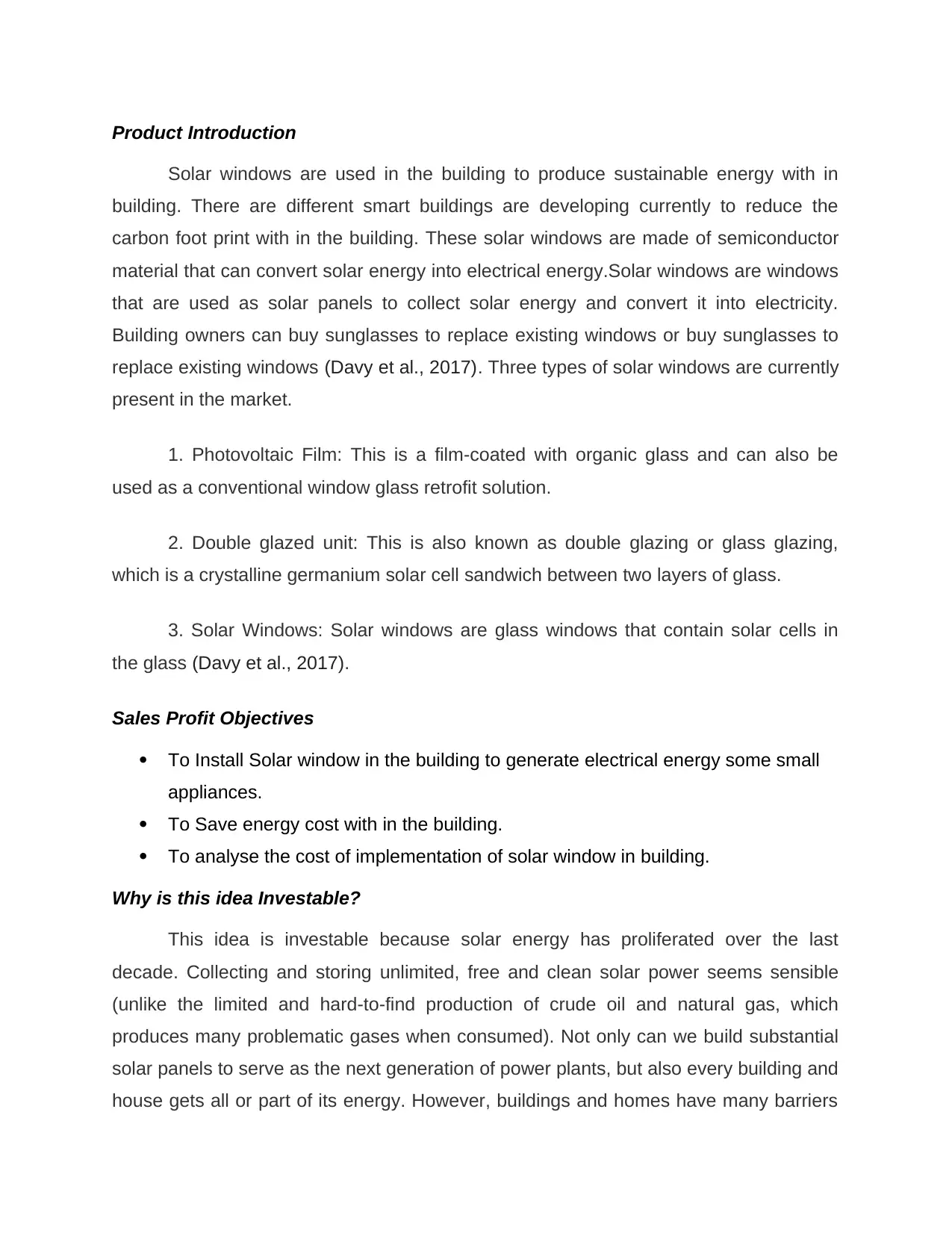
Product Introduction
Solar windows are used in the building to produce sustainable energy with in
building. There are different smart buildings are developing currently to reduce the
carbon foot print with in the building. These solar windows are made of semiconductor
material that can convert solar energy into electrical energy.Solar windows are windows
that are used as solar panels to collect solar energy and convert it into electricity.
Building owners can buy sunglasses to replace existing windows or buy sunglasses to
replace existing windows (Davy et al., 2017). Three types of solar windows are currently
present in the market.
1. Photovoltaic Film: This is a film-coated with organic glass and can also be
used as a conventional window glass retrofit solution.
2. Double glazed unit: This is also known as double glazing or glass glazing,
which is a crystalline germanium solar cell sandwich between two layers of glass.
3. Solar Windows: Solar windows are glass windows that contain solar cells in
the glass (Davy et al., 2017).
Sales Profit Objectives
To Install Solar window in the building to generate electrical energy some small
appliances.
To Save energy cost with in the building.
To analyse the cost of implementation of solar window in building.
Why is this idea Investable?
This idea is investable because solar energy has proliferated over the last
decade. Collecting and storing unlimited, free and clean solar power seems sensible
(unlike the limited and hard-to-find production of crude oil and natural gas, which
produces many problematic gases when consumed). Not only can we build substantial
solar panels to serve as the next generation of power plants, but also every building and
house gets all or part of its energy. However, buildings and homes have many barriers
Solar windows are used in the building to produce sustainable energy with in
building. There are different smart buildings are developing currently to reduce the
carbon foot print with in the building. These solar windows are made of semiconductor
material that can convert solar energy into electrical energy.Solar windows are windows
that are used as solar panels to collect solar energy and convert it into electricity.
Building owners can buy sunglasses to replace existing windows or buy sunglasses to
replace existing windows (Davy et al., 2017). Three types of solar windows are currently
present in the market.
1. Photovoltaic Film: This is a film-coated with organic glass and can also be
used as a conventional window glass retrofit solution.
2. Double glazed unit: This is also known as double glazing or glass glazing,
which is a crystalline germanium solar cell sandwich between two layers of glass.
3. Solar Windows: Solar windows are glass windows that contain solar cells in
the glass (Davy et al., 2017).
Sales Profit Objectives
To Install Solar window in the building to generate electrical energy some small
appliances.
To Save energy cost with in the building.
To analyse the cost of implementation of solar window in building.
Why is this idea Investable?
This idea is investable because solar energy has proliferated over the last
decade. Collecting and storing unlimited, free and clean solar power seems sensible
(unlike the limited and hard-to-find production of crude oil and natural gas, which
produces many problematic gases when consumed). Not only can we build substantial
solar panels to serve as the next generation of power plants, but also every building and
house gets all or part of its energy. However, buildings and homes have many barriers
Paraphrase This Document
Need a fresh take? Get an instant paraphrase of this document with our AI Paraphraser

to solar panels (Davy et al., 2017). First, the aesthetic effect of solar panels is not so
obvious. Another related issue is that panel-mounted solar cells are typically placed on
the roof to share space with HVAC systems, emergency exits, and other maintenance
facilities. While this is a sensible place to install panels, it also means that the roof area
(valuable property in the city) cannot be used for greened decks, plants or gardens
(Lunt and Zhao et al., 2019).
When considering the greening of smaller dwellings, some owners had to choose
between offering green space/outdoor fencing and solar panels. When considering
ways to make urban areas healthier and greener, we want to stop using rooftops or food
and entertainment in green spaces, but at the expense of creating clean, cheap energy
(Lunt and Zhao et al., 2019). They allow even more windows to be used per square foot
in new buildings, which also has the advantage of allowing/using natural daylight (using
passive solar heat in winter), thereby reducing electricity consumption - doubling the
amount of energy saved. Larger windows are also more popular than ever in new
buildings, and the cost savings can be significant. Instead of buying and installing
separate solar panels, solar panels can be installed as standard windows, and the
additional cost of a solar window is small compared to conventional windows. Because
solar panels are associated with the availability of silicon, solar cell windows can also
save you money because they are not germanium-based but can be made from
different types of cheap plastic. The increase in investment costs is estimated to be
three to five years (Davy et al., 2017).
Customer Value proposition
The mission of the company is to make the world sustainable windows through the use
of engaging in the mass market. An important part of achieving this goal is the
desirability of sustainable windows. To this end, the company created an online
experience to promote car awareness and appeal to promote their windows and brands.
obvious. Another related issue is that panel-mounted solar cells are typically placed on
the roof to share space with HVAC systems, emergency exits, and other maintenance
facilities. While this is a sensible place to install panels, it also means that the roof area
(valuable property in the city) cannot be used for greened decks, plants or gardens
(Lunt and Zhao et al., 2019).
When considering the greening of smaller dwellings, some owners had to choose
between offering green space/outdoor fencing and solar panels. When considering
ways to make urban areas healthier and greener, we want to stop using rooftops or food
and entertainment in green spaces, but at the expense of creating clean, cheap energy
(Lunt and Zhao et al., 2019). They allow even more windows to be used per square foot
in new buildings, which also has the advantage of allowing/using natural daylight (using
passive solar heat in winter), thereby reducing electricity consumption - doubling the
amount of energy saved. Larger windows are also more popular than ever in new
buildings, and the cost savings can be significant. Instead of buying and installing
separate solar panels, solar panels can be installed as standard windows, and the
additional cost of a solar window is small compared to conventional windows. Because
solar panels are associated with the availability of silicon, solar cell windows can also
save you money because they are not germanium-based but can be made from
different types of cheap plastic. The increase in investment costs is estimated to be
three to five years (Davy et al., 2017).
Customer Value proposition
The mission of the company is to make the world sustainable windows through the use
of engaging in the mass market. An important part of achieving this goal is the
desirability of sustainable windows. To this end, the company created an online
experience to promote car awareness and appeal to promote their windows and brands.
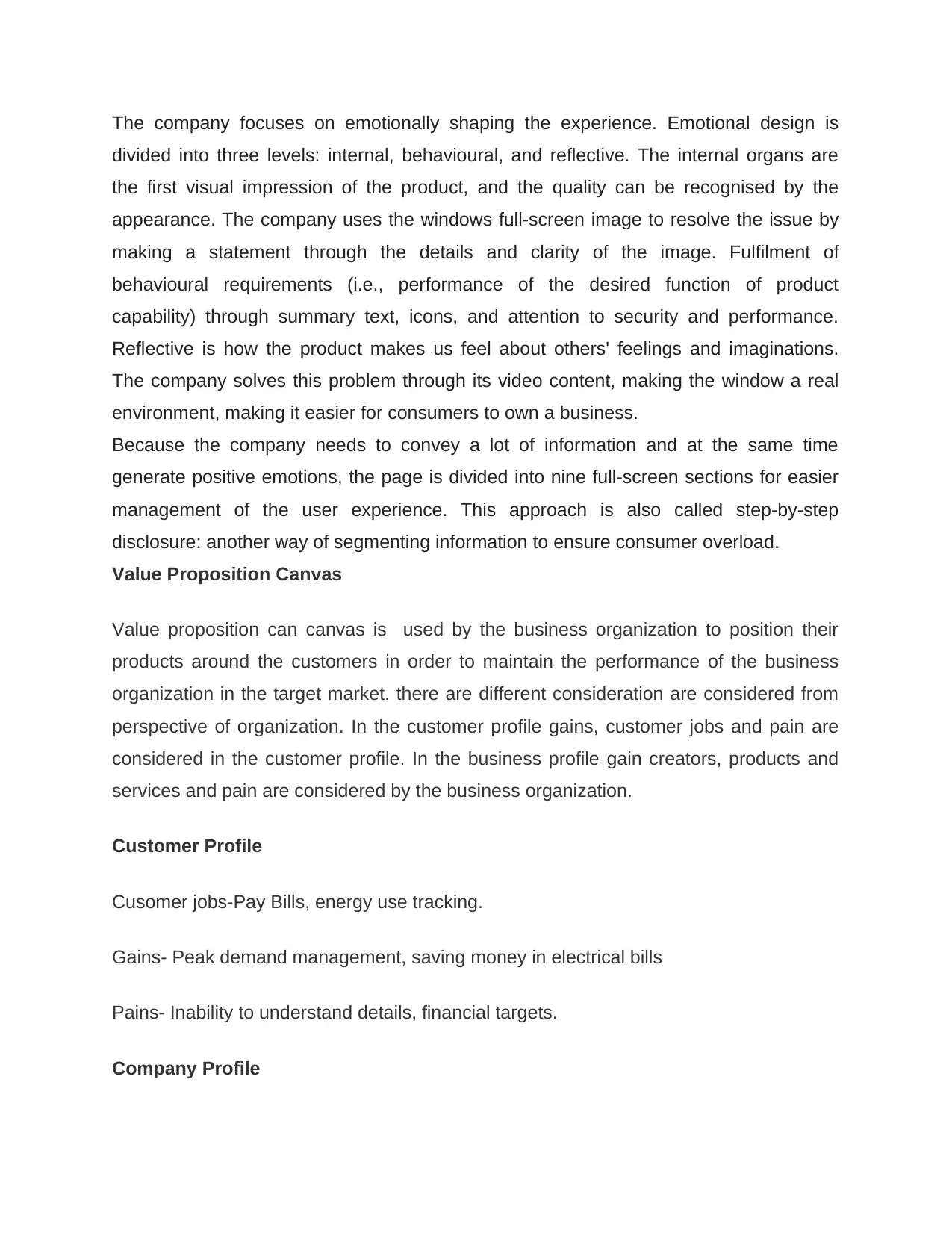
The company focuses on emotionally shaping the experience. Emotional design is
divided into three levels: internal, behavioural, and reflective. The internal organs are
the first visual impression of the product, and the quality can be recognised by the
appearance. The company uses the windows full-screen image to resolve the issue by
making a statement through the details and clarity of the image. Fulfilment of
behavioural requirements (i.e., performance of the desired function of product
capability) through summary text, icons, and attention to security and performance.
Reflective is how the product makes us feel about others' feelings and imaginations.
The company solves this problem through its video content, making the window a real
environment, making it easier for consumers to own a business.
Because the company needs to convey a lot of information and at the same time
generate positive emotions, the page is divided into nine full-screen sections for easier
management of the user experience. This approach is also called step-by-step
disclosure: another way of segmenting information to ensure consumer overload.
Value Proposition Canvas
Value proposition can canvas is used by the business organization to position their
products around the customers in order to maintain the performance of the business
organization in the target market. there are different consideration are considered from
perspective of organization. In the customer profile gains, customer jobs and pain are
considered in the customer profile. In the business profile gain creators, products and
services and pain are considered by the business organization.
Customer Profile
Cusomer jobs-Pay Bills, energy use tracking.
Gains- Peak demand management, saving money in electrical bills
Pains- Inability to understand details, financial targets.
Company Profile
divided into three levels: internal, behavioural, and reflective. The internal organs are
the first visual impression of the product, and the quality can be recognised by the
appearance. The company uses the windows full-screen image to resolve the issue by
making a statement through the details and clarity of the image. Fulfilment of
behavioural requirements (i.e., performance of the desired function of product
capability) through summary text, icons, and attention to security and performance.
Reflective is how the product makes us feel about others' feelings and imaginations.
The company solves this problem through its video content, making the window a real
environment, making it easier for consumers to own a business.
Because the company needs to convey a lot of information and at the same time
generate positive emotions, the page is divided into nine full-screen sections for easier
management of the user experience. This approach is also called step-by-step
disclosure: another way of segmenting information to ensure consumer overload.
Value Proposition Canvas
Value proposition can canvas is used by the business organization to position their
products around the customers in order to maintain the performance of the business
organization in the target market. there are different consideration are considered from
perspective of organization. In the customer profile gains, customer jobs and pain are
considered in the customer profile. In the business profile gain creators, products and
services and pain are considered by the business organization.
Customer Profile
Cusomer jobs-Pay Bills, energy use tracking.
Gains- Peak demand management, saving money in electrical bills
Pains- Inability to understand details, financial targets.
Company Profile
⊘ This is a preview!⊘
Do you want full access?
Subscribe today to unlock all pages.

Trusted by 1+ million students worldwide

Gain Creator- Real time analysis, auto update local energy rates.
Products and Services- Customer analytics, historic reporting, mobile cloud integration.
Pain Reliever- override Thresholds, Integrated Metering.
Lean Business Model
Lean business models help the company or the production to analysis the
significance of the product and the importance to which the product can provide a
solution. The lean business model comprises of nine parameters that enable the
product to prove effective and helps the product manufacturers to target the market
associated with the product (Husby and Hamilton, 2017). The nine parameters include
problem allocation, customer segmentation, customer value proposition, problem
solutions, and channels of programs, revenue streams, costing structures, unfair
advantages and key metrics (Husby and Hamilton, 2017). For glazing windows, the
parameters of the lean business model are expressed as follows.
Problem Allocation
The major issue that enabled the researchers to come up with the idea of
intervention of glazing windows also referred as sustainable windows are the rise in
temperature of the rooms and the additional energy wasted by the room coolers to
maintain the energy. The windows placed at the outside of buildings and the glass
exterior utilised by several buildings for the purpose of beauty make the interior
temperature of the rooms adequate for the residents to bear. Moreover, the
conventional windows are usually closed and can be replaced with other sources which
could help the community and the residents of buildings.
Customer Segmentation
Customer segment refers to the category of consumers targeted by the
manufacturers where the product has better performance in terms of productivity
(Olleros, 2017). The majority of consumer market targeted by the manufacturers of
glazing windows includes constructors and architectural engineering firms which
develop high rise buildings. The target markets also include the individuals or industry
Products and Services- Customer analytics, historic reporting, mobile cloud integration.
Pain Reliever- override Thresholds, Integrated Metering.
Lean Business Model
Lean business models help the company or the production to analysis the
significance of the product and the importance to which the product can provide a
solution. The lean business model comprises of nine parameters that enable the
product to prove effective and helps the product manufacturers to target the market
associated with the product (Husby and Hamilton, 2017). The nine parameters include
problem allocation, customer segmentation, customer value proposition, problem
solutions, and channels of programs, revenue streams, costing structures, unfair
advantages and key metrics (Husby and Hamilton, 2017). For glazing windows, the
parameters of the lean business model are expressed as follows.
Problem Allocation
The major issue that enabled the researchers to come up with the idea of
intervention of glazing windows also referred as sustainable windows are the rise in
temperature of the rooms and the additional energy wasted by the room coolers to
maintain the energy. The windows placed at the outside of buildings and the glass
exterior utilised by several buildings for the purpose of beauty make the interior
temperature of the rooms adequate for the residents to bear. Moreover, the
conventional windows are usually closed and can be replaced with other sources which
could help the community and the residents of buildings.
Customer Segmentation
Customer segment refers to the category of consumers targeted by the
manufacturers where the product has better performance in terms of productivity
(Olleros, 2017). The majority of consumer market targeted by the manufacturers of
glazing windows includes constructors and architectural engineering firms which
develop high rise buildings. The target markets also include the individuals or industry
Paraphrase This Document
Need a fresh take? Get an instant paraphrase of this document with our AI Paraphraser

owners who look to produce sustainable energy and save the environment. The
manufacturers also target the societies that encourage sustainable energy and favour
safeguarding the resources for future generations. The societies that favour usage of
regeneration of energy through energy-efficient means need to be considered in order
to market the product and increase the awareness of the product within the
manufacturers.
Customer Value Proposition
The unique proposition of value associated with the developed product is the
production of sustainable energy from a product which is not adequately used. The
ability of product is to produce energy that can be utilised to reduce the electricity bills
and the maintenance of the pleasant environment in the inside of a building for which
the user is spending money and budget.
Problem Solution
Incorporation of developed product in the usage conditions help the
manufacturers to make an object produce electricity and sustainable energy which was
only used as a ventilating source in warm weather or an emergency exit in case of fire
(Kullmar and Lallerstedt, 2017). The use of glazed windows enables the consumers to
maintain the required atmosphere in the inside of the building. The product can also
provide a great opportunity for centrally air-conditioned buildings to make use of the
windows for the purpose of electricity generation as these buildings do not require
windows for the purpose of ventilation.
Channel of Programs
Channel refers to the medium with which the consumer market is targeted by the
manufacturers or marketers (Wahl, 2016). The channel utilised for promotion of glazed
windows includes all the platforms which could create awareness among the societies.
The first measure is to attract the communities or societies which focus on the provision
of sustainable energy to the users and the safeguard of natural reserves and resources
for future generations. Moreover, the societies concerned about the environmental
conditions also need to be made aware related to the product and made sure that the
manufacturers also target the societies that encourage sustainable energy and favour
safeguarding the resources for future generations. The societies that favour usage of
regeneration of energy through energy-efficient means need to be considered in order
to market the product and increase the awareness of the product within the
manufacturers.
Customer Value Proposition
The unique proposition of value associated with the developed product is the
production of sustainable energy from a product which is not adequately used. The
ability of product is to produce energy that can be utilised to reduce the electricity bills
and the maintenance of the pleasant environment in the inside of a building for which
the user is spending money and budget.
Problem Solution
Incorporation of developed product in the usage conditions help the
manufacturers to make an object produce electricity and sustainable energy which was
only used as a ventilating source in warm weather or an emergency exit in case of fire
(Kullmar and Lallerstedt, 2017). The use of glazed windows enables the consumers to
maintain the required atmosphere in the inside of the building. The product can also
provide a great opportunity for centrally air-conditioned buildings to make use of the
windows for the purpose of electricity generation as these buildings do not require
windows for the purpose of ventilation.
Channel of Programs
Channel refers to the medium with which the consumer market is targeted by the
manufacturers or marketers (Wahl, 2016). The channel utilised for promotion of glazed
windows includes all the platforms which could create awareness among the societies.
The first measure is to attract the communities or societies which focus on the provision
of sustainable energy to the users and the safeguard of natural reserves and resources
for future generations. Moreover, the societies concerned about the environmental
conditions also need to be made aware related to the product and made sure that the
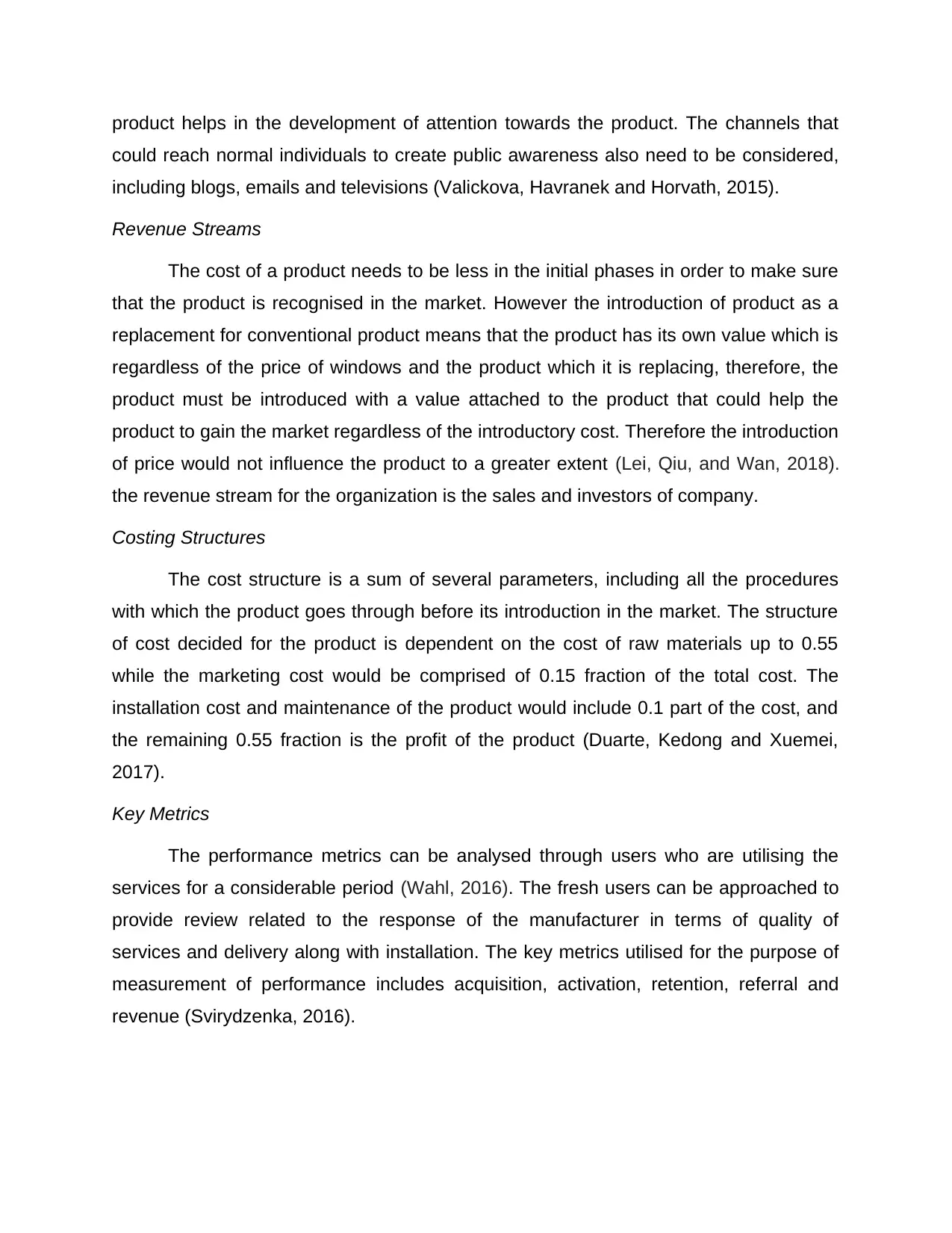
product helps in the development of attention towards the product. The channels that
could reach normal individuals to create public awareness also need to be considered,
including blogs, emails and televisions (Valickova, Havranek and Horvath, 2015).
Revenue Streams
The cost of a product needs to be less in the initial phases in order to make sure
that the product is recognised in the market. However the introduction of product as a
replacement for conventional product means that the product has its own value which is
regardless of the price of windows and the product which it is replacing, therefore, the
product must be introduced with a value attached to the product that could help the
product to gain the market regardless of the introductory cost. Therefore the introduction
of price would not influence the product to a greater extent (Lei, Qiu, and Wan, 2018).
the revenue stream for the organization is the sales and investors of company.
Costing Structures
The cost structure is a sum of several parameters, including all the procedures
with which the product goes through before its introduction in the market. The structure
of cost decided for the product is dependent on the cost of raw materials up to 0.55
while the marketing cost would be comprised of 0.15 fraction of the total cost. The
installation cost and maintenance of the product would include 0.1 part of the cost, and
the remaining 0.55 fraction is the profit of the product (Duarte, Kedong and Xuemei,
2017).
Key Metrics
The performance metrics can be analysed through users who are utilising the
services for a considerable period (Wahl, 2016). The fresh users can be approached to
provide review related to the response of the manufacturer in terms of quality of
services and delivery along with installation. The key metrics utilised for the purpose of
measurement of performance includes acquisition, activation, retention, referral and
revenue (Svirydzenka, 2016).
could reach normal individuals to create public awareness also need to be considered,
including blogs, emails and televisions (Valickova, Havranek and Horvath, 2015).
Revenue Streams
The cost of a product needs to be less in the initial phases in order to make sure
that the product is recognised in the market. However the introduction of product as a
replacement for conventional product means that the product has its own value which is
regardless of the price of windows and the product which it is replacing, therefore, the
product must be introduced with a value attached to the product that could help the
product to gain the market regardless of the introductory cost. Therefore the introduction
of price would not influence the product to a greater extent (Lei, Qiu, and Wan, 2018).
the revenue stream for the organization is the sales and investors of company.
Costing Structures
The cost structure is a sum of several parameters, including all the procedures
with which the product goes through before its introduction in the market. The structure
of cost decided for the product is dependent on the cost of raw materials up to 0.55
while the marketing cost would be comprised of 0.15 fraction of the total cost. The
installation cost and maintenance of the product would include 0.1 part of the cost, and
the remaining 0.55 fraction is the profit of the product (Duarte, Kedong and Xuemei,
2017).
Key Metrics
The performance metrics can be analysed through users who are utilising the
services for a considerable period (Wahl, 2016). The fresh users can be approached to
provide review related to the response of the manufacturer in terms of quality of
services and delivery along with installation. The key metrics utilised for the purpose of
measurement of performance includes acquisition, activation, retention, referral and
revenue (Svirydzenka, 2016).
⊘ This is a preview!⊘
Do you want full access?
Subscribe today to unlock all pages.

Trusted by 1+ million students worldwide

Unfair Advantage
Glazed windows are provided with value for the consumers depending upon the
quantity and loyalty of consumers. With the increased loyalty of consumers and quantity
of buying the product will be provided with the service of provision of warranty for the
product along with maintenance of services to enable the product to run on maximum
performances (Čirjevskis, 2019).
Customer Marketing Engagement Plan
It is important for the business to engage with customers is about encouraging
customers to interact and share the experiences which are created as a company and
as a brand (Payne, Frow, and Eggert, 2017). When properly implemented, a strong
strategy of customer engagement would promote brand loyalty, positive brand image
and loyalty (Davy et al. 2017).
Companies that focus on customer engagement focus on creating value instead
of generating revenue. They provide people with meaningful things in addition to sales:
great end-customer experience, rich content, or real-time interactive customer support
(Husby and Hamilton, 2017).
Glazed windows are provided with value for the consumers depending upon the
quantity and loyalty of consumers. With the increased loyalty of consumers and quantity
of buying the product will be provided with the service of provision of warranty for the
product along with maintenance of services to enable the product to run on maximum
performances (Čirjevskis, 2019).
Customer Marketing Engagement Plan
It is important for the business to engage with customers is about encouraging
customers to interact and share the experiences which are created as a company and
as a brand (Payne, Frow, and Eggert, 2017). When properly implemented, a strong
strategy of customer engagement would promote brand loyalty, positive brand image
and loyalty (Davy et al. 2017).
Companies that focus on customer engagement focus on creating value instead
of generating revenue. They provide people with meaningful things in addition to sales:
great end-customer experience, rich content, or real-time interactive customer support
(Husby and Hamilton, 2017).
Paraphrase This Document
Need a fresh take? Get an instant paraphrase of this document with our AI Paraphraser
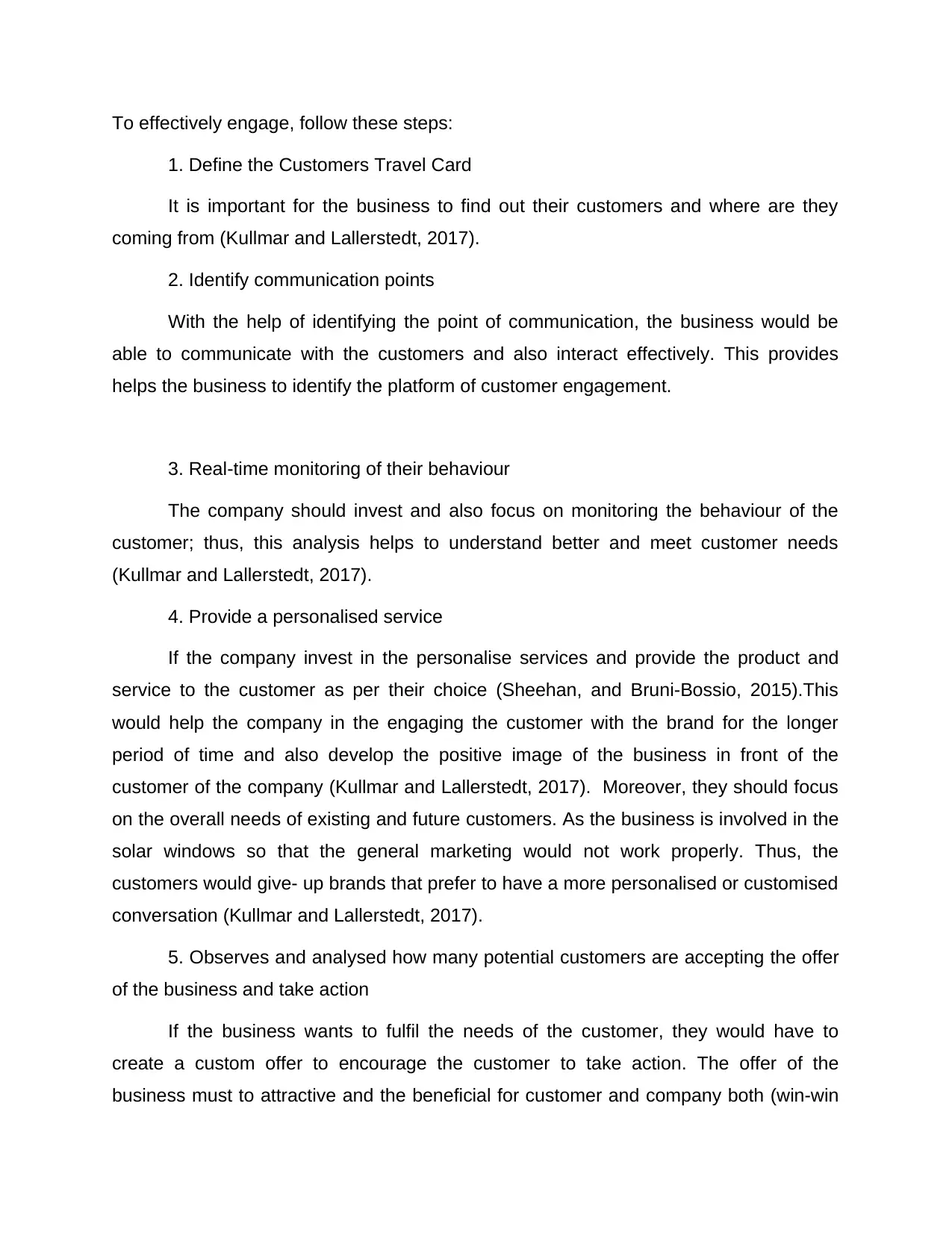
To effectively engage, follow these steps:
1. Define the Customers Travel Card
It is important for the business to find out their customers and where are they
coming from (Kullmar and Lallerstedt, 2017).
2. Identify communication points
With the help of identifying the point of communication, the business would be
able to communicate with the customers and also interact effectively. This provides
helps the business to identify the platform of customer engagement.
3. Real-time monitoring of their behaviour
The company should invest and also focus on monitoring the behaviour of the
customer; thus, this analysis helps to understand better and meet customer needs
(Kullmar and Lallerstedt, 2017).
4. Provide a personalised service
If the company invest in the personalise services and provide the product and
service to the customer as per their choice (Sheehan, and Bruni-Bossio, 2015).This
would help the company in the engaging the customer with the brand for the longer
period of time and also develop the positive image of the business in front of the
customer of the company (Kullmar and Lallerstedt, 2017). Moreover, they should focus
on the overall needs of existing and future customers. As the business is involved in the
solar windows so that the general marketing would not work properly. Thus, the
customers would give- up brands that prefer to have a more personalised or customised
conversation (Kullmar and Lallerstedt, 2017).
5. Observes and analysed how many potential customers are accepting the offer
of the business and take action
If the business wants to fulfil the needs of the customer, they would have to
create a custom offer to encourage the customer to take action. The offer of the
business must to attractive and the beneficial for customer and company both (win-win
1. Define the Customers Travel Card
It is important for the business to find out their customers and where are they
coming from (Kullmar and Lallerstedt, 2017).
2. Identify communication points
With the help of identifying the point of communication, the business would be
able to communicate with the customers and also interact effectively. This provides
helps the business to identify the platform of customer engagement.
3. Real-time monitoring of their behaviour
The company should invest and also focus on monitoring the behaviour of the
customer; thus, this analysis helps to understand better and meet customer needs
(Kullmar and Lallerstedt, 2017).
4. Provide a personalised service
If the company invest in the personalise services and provide the product and
service to the customer as per their choice (Sheehan, and Bruni-Bossio, 2015).This
would help the company in the engaging the customer with the brand for the longer
period of time and also develop the positive image of the business in front of the
customer of the company (Kullmar and Lallerstedt, 2017). Moreover, they should focus
on the overall needs of existing and future customers. As the business is involved in the
solar windows so that the general marketing would not work properly. Thus, the
customers would give- up brands that prefer to have a more personalised or customised
conversation (Kullmar and Lallerstedt, 2017).
5. Observes and analysed how many potential customers are accepting the offer
of the business and take action
If the business wants to fulfil the needs of the customer, they would have to
create a custom offer to encourage the customer to take action. The offer of the
business must to attractive and the beneficial for customer and company both (win-win
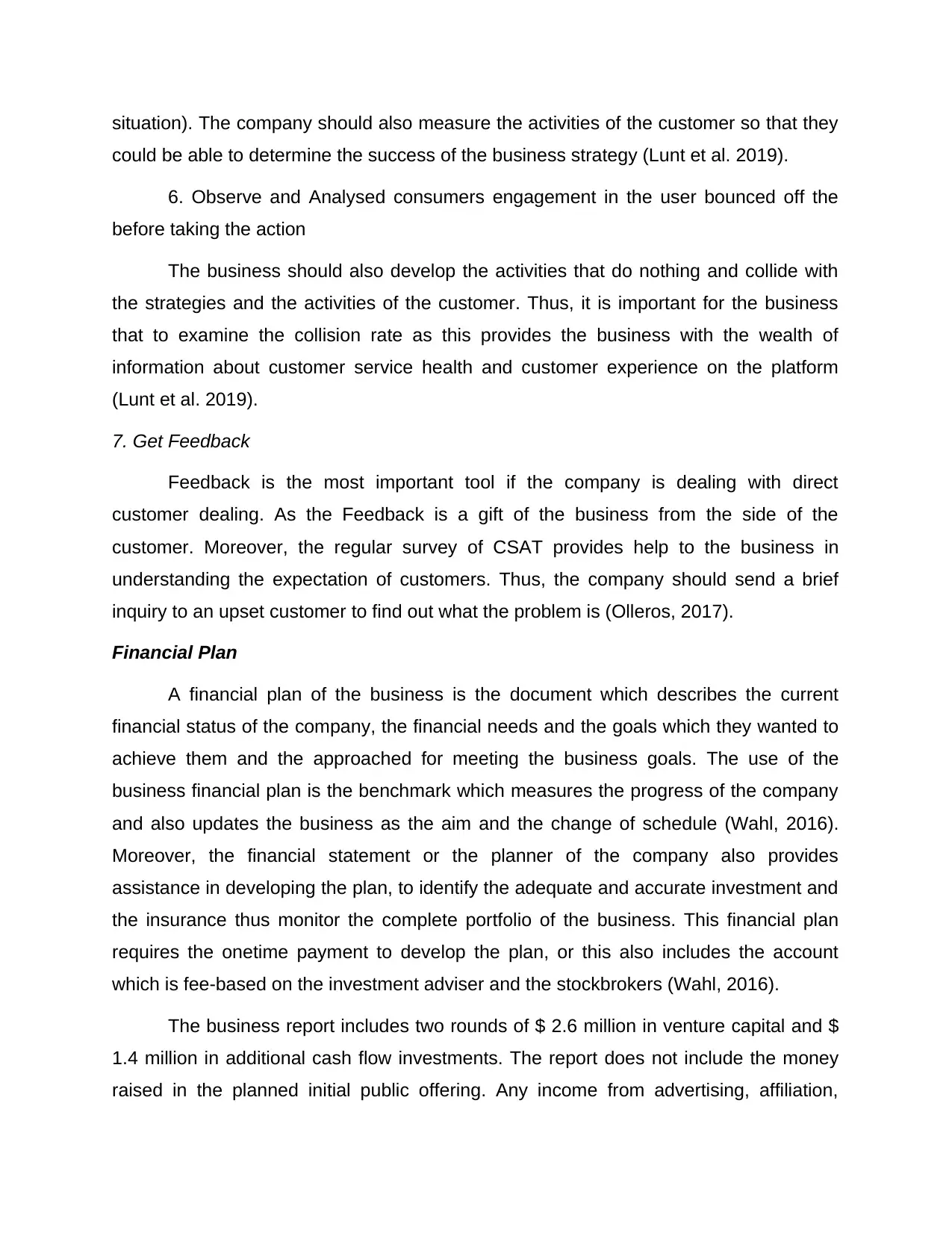
situation). The company should also measure the activities of the customer so that they
could be able to determine the success of the business strategy (Lunt et al. 2019).
6. Observe and Analysed consumers engagement in the user bounced off the
before taking the action
The business should also develop the activities that do nothing and collide with
the strategies and the activities of the customer. Thus, it is important for the business
that to examine the collision rate as this provides the business with the wealth of
information about customer service health and customer experience on the platform
(Lunt et al. 2019).
7. Get Feedback
Feedback is the most important tool if the company is dealing with direct
customer dealing. As the Feedback is a gift of the business from the side of the
customer. Moreover, the regular survey of CSAT provides help to the business in
understanding the expectation of customers. Thus, the company should send a brief
inquiry to an upset customer to find out what the problem is (Olleros, 2017).
Financial Plan
A financial plan of the business is the document which describes the current
financial status of the company, the financial needs and the goals which they wanted to
achieve them and the approached for meeting the business goals. The use of the
business financial plan is the benchmark which measures the progress of the company
and also updates the business as the aim and the change of schedule (Wahl, 2016).
Moreover, the financial statement or the planner of the company also provides
assistance in developing the plan, to identify the adequate and accurate investment and
the insurance thus monitor the complete portfolio of the business. This financial plan
requires the onetime payment to develop the plan, or this also includes the account
which is fee-based on the investment adviser and the stockbrokers (Wahl, 2016).
The business report includes two rounds of $ 2.6 million in venture capital and $
1.4 million in additional cash flow investments. The report does not include the money
raised in the planned initial public offering. Any income from advertising, affiliation,
could be able to determine the success of the business strategy (Lunt et al. 2019).
6. Observe and Analysed consumers engagement in the user bounced off the
before taking the action
The business should also develop the activities that do nothing and collide with
the strategies and the activities of the customer. Thus, it is important for the business
that to examine the collision rate as this provides the business with the wealth of
information about customer service health and customer experience on the platform
(Lunt et al. 2019).
7. Get Feedback
Feedback is the most important tool if the company is dealing with direct
customer dealing. As the Feedback is a gift of the business from the side of the
customer. Moreover, the regular survey of CSAT provides help to the business in
understanding the expectation of customers. Thus, the company should send a brief
inquiry to an upset customer to find out what the problem is (Olleros, 2017).
Financial Plan
A financial plan of the business is the document which describes the current
financial status of the company, the financial needs and the goals which they wanted to
achieve them and the approached for meeting the business goals. The use of the
business financial plan is the benchmark which measures the progress of the company
and also updates the business as the aim and the change of schedule (Wahl, 2016).
Moreover, the financial statement or the planner of the company also provides
assistance in developing the plan, to identify the adequate and accurate investment and
the insurance thus monitor the complete portfolio of the business. This financial plan
requires the onetime payment to develop the plan, or this also includes the account
which is fee-based on the investment adviser and the stockbrokers (Wahl, 2016).
The business report includes two rounds of $ 2.6 million in venture capital and $
1.4 million in additional cash flow investments. The report does not include the money
raised in the planned initial public offering. Any income from advertising, affiliation,
⊘ This is a preview!⊘
Do you want full access?
Subscribe today to unlock all pages.

Trusted by 1+ million students worldwide
1 out of 24
Your All-in-One AI-Powered Toolkit for Academic Success.
+13062052269
info@desklib.com
Available 24*7 on WhatsApp / Email
![[object Object]](/_next/static/media/star-bottom.7253800d.svg)
Unlock your academic potential
Copyright © 2020–2025 A2Z Services. All Rights Reserved. Developed and managed by ZUCOL.

